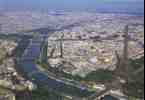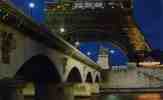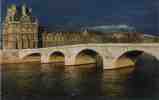![]()
 Paris is small: no corner is farther than six miles from the square
in front of Notre-Dame Cathedral. The city has a total area of 41
square miles (105 square kilometres), if the two big parks at
either extremity are included, and 34 square miles without them.
The city occupies a bowl hollowed out by the Seine in its
prehistoric vigour, and the surrounding heights have been
respected as the limits of the city. The river arches through the
center of town, visiting 10 of the 20 arrondissements. Entering
the city at the southeast corner, it arcs northward and bends out
of Paris at the southwest corner. As a result, what starts out as
the streams east bank becomes its north bank and ends as the
west bank, and the Parisians therefore adopted the simple,
unchanging designation of Right and Left Bank (when facing
downstream). These terms are not much used in conversation, as
specific places are usually indicated by arrondissement (e.g.,
quinzième) or by quartier (e.g., Observatoire).
Paris is small: no corner is farther than six miles from the square
in front of Notre-Dame Cathedral. The city has a total area of 41
square miles (105 square kilometres), if the two big parks at
either extremity are included, and 34 square miles without them.
The city occupies a bowl hollowed out by the Seine in its
prehistoric vigour, and the surrounding heights have been
respected as the limits of the city. The river arches through the
center of town, visiting 10 of the 20 arrondissements. Entering
the city at the southeast corner, it arcs northward and bends out
of Paris at the southwest corner. As a result, what starts out as
the streams east bank becomes its north bank and ends as the
west bank, and the Parisians therefore adopted the simple,
unchanging designation of Right and Left Bank (when facing
downstream). These terms are not much used in conversation, as
specific places are usually indicated by arrondissement (e.g.,
quinzième) or by quartier (e.g., Observatoire).
 At water level, some 30 feet below street level, the river is
bordered--at least on those portions not transformed into
expressways--by cobbled quays graced with trees and shrubs.
From street level another line of trees leans towards the water.
Between the two levels, the retaining walls, usually made of
massive stone blocks, are decorated with the great iron rings of a
past ages commerce and sometimes pierced by mysterious
openings (water gates for old palaces or inspection ports for
subways, sewers and underpasses). Here and there the wall is
shawled in ivy.
At water level, some 30 feet below street level, the river is
bordered--at least on those portions not transformed into
expressways--by cobbled quays graced with trees and shrubs.
From street level another line of trees leans towards the water.
Between the two levels, the retaining walls, usually made of
massive stone blocks, are decorated with the great iron rings of a
past ages commerce and sometimes pierced by mysterious
openings (water gates for old palaces or inspection ports for
subways, sewers and underpasses). Here and there the wall is
shawled in ivy.
 The old buildings, the riverboats, the changes of colour reflected
by the water, the gardens, and the 32 bridges (many of them
handsome) compose one of the worlds grandest, yet most
endearing cityscapes. Along the river are two of the great set
pieces of urban spectacle in the contemporary world. The first
sweeps down from the Palais de Chaillot on the Right Bank,
crosses the river to the Eiffel Tower, and continues through the
gardens of the Champ-de-Mars to the 18th-century Ecole
Militaire; the other begins at the Seine and marches up a broad
esplanade to the golden dome of the Invalides.
The old buildings, the riverboats, the changes of colour reflected
by the water, the gardens, and the 32 bridges (many of them
handsome) compose one of the worlds grandest, yet most
endearing cityscapes. Along the river are two of the great set
pieces of urban spectacle in the contemporary world. The first
sweeps down from the Palais de Chaillot on the Right Bank,
crosses the river to the Eiffel Tower, and continues through the
gardens of the Champ-de-Mars to the 18th-century Ecole
Militaire; the other begins at the Seine and marches up a broad
esplanade to the golden dome of the Invalides.